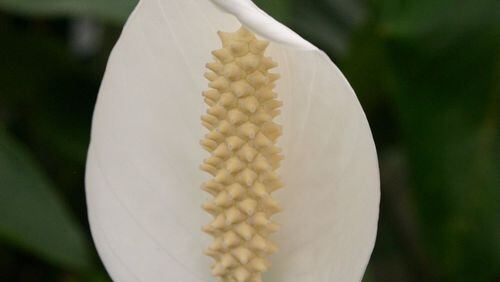Q: I was given a peace lily in 2009. I replanted it into a larger pot, but it is now very large. How do I trim it back? — Tina Murray, email
A: I think your best bet is to simply divide the big plant into two. Spread newspapers on the floor and carefully slide the plant out of the pot. You should be able to see individual thick roots that have several leaves attached to them. Use a sharp knife or heavy shears to cut apart the roots while keeping the leaves attached. Plant them in separate pots with fresh potting soil and fertilize lightly with liquid fertilizer.
Q: Is it possible to grow kumquats in Atlanta? — Cindy Shapiro, email
A: It's possible, but you won't be able to keep it outdoors all year long. Local kumquat grower Jason Byers said he gets dozens of fruit from a small potted tree he takes outdoors in spring and keeps indoors in winter. St. Joseph, Fla., north of Tampa, is the center of kumquat production in the Southeast. If you buy a plant online, plant it in a large pot (18 inches minimum). Water and fertilize regularly in summer and put it in a sunny room indoors for winter. Although a kumquat can tolerate occasional freezing temperatures, you'll be pushing the envelope if you don't bring it indoors in October.
Q: Please give me advice on Solomon's seal. Is it disease-resistant? — Valerie Carson, Sandy Springs
A: Solomon's seal, Polygonatum multiflorum, is an excellent plant! The variegated form is my favorite. The leaves are a striking green and white during the spring, summer and fall, and turn a nice golden yellow when they fade in October. It needs partial shade and soil that stays somewhat moist during summertime. Plants spread slowly via thick roots to make an attractive patch. I've never noticed pests or disease on mine.
Q: I use magnolia leaves to wrap Christmas presents. I had a hard time finding leaves with brown backs this year so I want to plant a magnolia with brown-backed leaves. — Carol Loudermilk, Eatonton
A: 'Bracken's Brown Beauty' is just right for you! The leaves sport attractive brown backsides and the tree grows to a compact 30 feet tall. Given full sunshine and soft soil in which to grow a few years, you should be able to harvest a plethora of leaves each winter.
Q: What causes black spots on the meat of pecans, and, if they are small spots, are they edible? — Anita Rainey, Barrow County
A: It's likely feeding damage from stinkbugs. In August, the insects stick their hollow snouts through the shell into a pecan nutmeat and suck some of the juice out of the immature kernel. Stink bug control begins with insecticide sprays in early summer, when the young insects are first present. You've eaten many similar spots on apples and pears, so I don't feel there's any danger in eating pecans with a few dark spots.
About the Author






